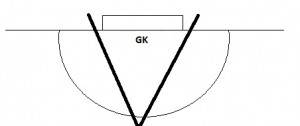Having played on teams where I got regularly shelled with shots, I often wondered whether being able to save the vast majority of them meant I was a better goalkeeper than those opposing ’keepers who had less work to do. However, as I moved up the leagues and changed teams, my opinion changed as I realised the importance of being able to make key saves at important times. Making that all important save can be a game changer, influencing the outcome of the game if the current score is close or the game is tied. By being able to make crucial saves when it counts, you are going to give your team a better chance of winning the game.
Quantity of shots
The strength of your defence and the way you organise it (as I wrote about recently) will have a big influence over the number of shots and scoring chances you will face in a game. Whilst you don’t always want to be facing a lot of shots, it can actually have a positive knock-on effect depending on how you play the ‘mental game’. I personally found myself to be a ‘rhythm’ goalkeeper (a term used for ice hockey goalies which refers to playing in a rhythm) as I would find it easier to concentrate better and play better when facing a lot of shots. If you consistently face a lot of shots, don’t take it personally and think of it more as a training session so you don’t get disheartened. I found it a quick way to learn the position being thrown in the deep end!
Quality matters
If you have strong technique and are a good shot stopper, then you are obviously going to be able to stop shots that are otherwise going to beat you. Whilst having more shots to stop looks better on paper, since your shots saved versus shots will obviously be a good representation of your ability, it is important to remember that the quality of shots is a better way of seeing how good you are. If the shots are easy (i.e. ‘soft’ goals if you fail to make the save), then a lot of easy saves aren’t going to test your core foot work and save technique, for example.
Quality over quantity
When playing competitively at good levels of hockey, you will notice that when playing behind a strong defence you will obviously face less scoring opportunities, which in essence makes your life harder! Any scoring chance therefore becomes more important because when the opposition does break through they are more likely to produce a shot that really tests you because they cannot waste opportunities. This in turn means that you are going to have to be prepared to stop it! With less shots coming your way, you also have to be much more alert because losing your attention and ‘dropping off’ will mean you make yourself beatable.
The following clip demonstrates this, with a close game and few shots:
http://www.youtube.com/watch?v=Xcjj4WnyXYU&feature=relmfu
Strong mindset
In contrast, facing few but hard to save shots is going to test your ability. Every shot is essentially an opportunity to prove yourself and focusing on a closed mindset of ‘one save at a time’ will help you direct your efforts and continue playing to a high level. Playing like it’s ‘0-0’ will also direct your attention away from worrying about the score line and help you focus on stopping those shots.
Quality not quantity
Ultimately, however many shots you face, you need to be able to stop shots no matter the quality. It could be argued that no matter the number of shots you face, when it comes down to the crunch, you need to save them! I think it’s harder to be a goalkeeper on a strong defensive team because if you only face one goal and you fail to stop it, you are going to under more scrutiny. Whilst it’s not really that fun to face a ridiculous amount of shots (as it can be disheartening over a long period of time), as you improve and get the chance to play on better teams, you’ll recognise the need to perform at key times in the match when it matters the most.
